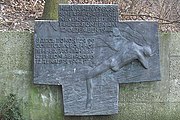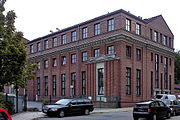Ostviertel (Essen)
|
[[File: | left | 40px | Coat of Arms of Ostviertel]] Ostviertel |
|

|
|
| Basic data | |
|---|---|
| surface | 1.88 km² |
| Residents | 7103 (March 31, 2020) |
| Coordinates | 51 ° 27 '37 " N , 7 ° 1' 44" E |
| height | 79 m |
| Spatial assignment | |
| Post Code | 45127, 45139 |
| District number | 02 |
| district | District I city center / Frillendorf / Huttrop |
| image | |
|
Former main bath of the city of Essen |
|
| Source: City of Essen statistics | |
The Ostviertel is a district of the city of Essen and together with the West district , the northern district , the south quarter , the southeast quarter and the town center the town center .
character
The east quarter consists mainly of dense residential areas and industrial settlements. The residential areas border directly on the city center and are separated from the commercial areas and industrial settlements by Goldschmidtstrasse. Due to the close location in the inner city area, the residential area is connected to the local public transport by several tram and bus lines of the Ruhrbahn .
Here is the former Essen main pool , a swimming pool for competitions with around 1000 grandstand seats, the Ruhrbahn depot, the main fire station and the long-established company Theodor Goldschmidt AG, which is now part of Evonik AG . In addition to the former technical center, the University of Duisburg-Essen also uses other buildings in the east quarter.
The St. Barbara Church, built in 1904, was badly damaged in World War II and repaired in 1965/1966. It was profaned in December 2014 and demolished in March 2020.
population
On March 31, 2020, 7,103 residents lived in the east quarter.
Structural data of the population in the east quarter (as of March 31, 2020):
- Proportion of population under 18-year-olds: 18.1% (Essen average: 16.2%)
- Population of at least 65-year-olds: 12.9% (Essen average: 21.5%)
- Proportion of foreigners: 39.4% (Essen average: 16.9%)
schools
In the east quarter there is the primary school Münsterschule , the special school Am Steeler Tor , the municipal Theodor-Goldschmidt-Realschule , the Nikolaus-Groß-Abendgymnasium and the Frida-Levy-Gesamtschule .
history
Located on the shuttle race 70 which is under monument protection, four-storey building of the former Royal Maschinenbauschule food , later pilot plant food, from 1909. This school was, like the Royal Baugewerkschule food at the Robert-Schmidt-Straße in the Southeast Quarter , from the In 1901, with the support of Friedrich Krupp AG , the state-municipal trade school emerged. At the back, the building is located on the Waldthausenpark road covered since the 17th century, based in Essen patrician - and industrialist family Waldthausen recalls. Important people emerged from the school who did important work for the economy of the Rhenish-Westphalian industrial area.
In Ostviertel there were several coal - mines , including the bill count Beust and the bill Hercules . After the latter was shut down, the Hercules Forced Labor Camp was set up in their buildings during the Nazi era .
Memorial for Russian forced laborers behind the Ruhrbahn depot
Administration building of the former Graf Beust colliery
Book burning in 1933
Gerlingplatz, named after the long-established Gerling family, was the scene of the book burning in Essen on June 21, 1933 .
In 1922 the square was renamed Republic Square . It was a traditional meeting place for the Essen workers' movement. On May 8, 1933, the name was changed to Platz des 21. März for the time of National Socialism . It was here that the late book burning took place in Essen on June 21, 1933, with piles of books being piled up and set on fire in other German cities as early as May 10 of that year. The SA had from the books u. a. from Thomas and Heinrich Mann , Erich Maria Remarque , Ernst Toller and Kurt Tucholsky a stake of un-German built, it wrote the Essen National newspaper . The SA standard leader Otto Dahlem set the mountain on fire when people from the SA and SS , members of the NSBO , boys in Hitler Youth uniforms, but also bystanders gathered. The writer Richard Euringer , who joined the National Socialists, had previously been appointed head of the Essen city library. At the book-burning he said: This writing will now go up in flames today. It's beautiful, symbolic, pictorial. Before that, he separated 18,000 volumes from the stock of the city library, the content of which contradicts the National Socialist world of ideas . Some of them fell victim to the book burning on Gerlingplatz. In 1945 Gerlingplatz got its old name back.
coat of arms
Blazon : "In blue an oblique left golden (yellow) sword, accompanied above and below by three golden (yellow) balls."
The coat of arms was designed by Kurt Schweder and never had an official character. At the end of the 1980s, the heraldist created coats of arms for all of Essen's districts. They have meanwhile been well received by the Essen population. The sword as an attribute of the city patrons Cosmas and Damian makes the reference to the Essen city coat of arms. The golden balls symbolize the six districts city center , north quarter , east quarter, southeast quarter , south quarter and west quarter .
See also
Web links
- Bunker Iron Hand , near the city of Essen
Individual evidence
- ^ Heinz Dohmen & Eckhard Sons: Churches, chapels, synagogues in Essen. Nobel, Essen 1998, ISBN 3-922785-52-2 .
- ↑ Population figures of the districts
- ↑ Proportion of the population under 18 years of age
- ↑ Proportion of the population aged 65 and over
- ↑ Proportion of foreigners in the city districts
- ^ The book burning in Essen. Retrieved January 25, 2020 .
- ↑ See on this Johann Rainer Busch: Kurt Schweders coat of arms of the Essen districts. Essen 2009, p. 48.






